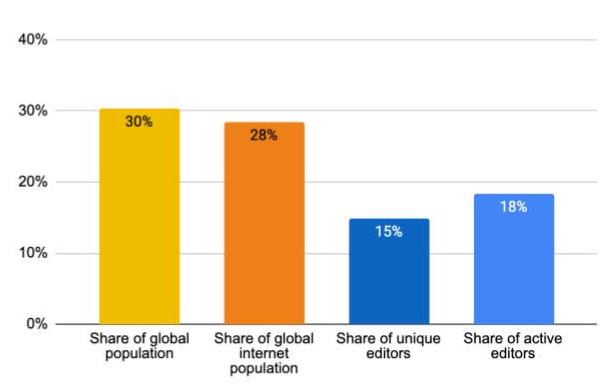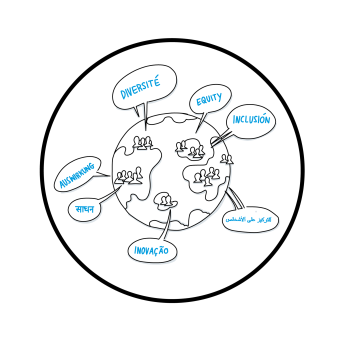“The world is run by those who show up”
Did you know that two-thirds of the monthly average page views of the Wikimedia projects in East Asia, Southeast Asia, and the Pacific region (ESEAP) come from mobile devices?
ESEAP spans 33 geographies and is home to 30% of the global population and an almost equal share of global internet users – 28%. It is a region with diverse cultures and languages and hosts 58 language editions (and counting) of Wikipedia. ESEAP is a region of great opportunity; over the past year, we have seen both successes and challenges that we can learn from as we continue to support our local communities.
Wikimedia Taiwan was the first organization to be recognized as an ESEAP affiliate in 2007. In the last 15 years, the number of affiliates has increased to 13, with the largest affiliate being Wikimedia Indonesia, in terms of grant funding received and affiliate membership size (100+). This number and footprint of our affiliates are set to increase in the coming years, as many are in the early stages of incorporation, non-profit registration, and setting up governance and administrative processes.
Growing knowledge equity through deeper regional learning
This year, as part of the Wikimedia Foundation Annual Plan, we introduced a focus on regional work as part of our own commitment to advancing knowledge equity and supporting the movement strategy. We are all part of a global movement that spans regions, languages, and communities, and this regional focus will allow the Foundation to better understand localized needs and regional trends as part of our work.
We launched this new approach at the beginning of this fiscal year by improving our coordination on a regional level. Foundation teams working in the regions and partnering with local communities now convene more intentionally around defining the impact that we can make together in different regions of the world. Each quarter, we will meet to discuss regional and historical trends and activities by individual volunteers, Chapters, User Groups, Thematic Organizations, and partner organizations in the free knowledge ecosystem. These sessions are an important check-in as part of our Annual Plan and look at planned work by various teams at the Foundation to prioritize and align resources for focused results and more impactful partnerships.
Learnings and Trends from ESEAP
An important trend to keep in mind is ESEAP’s high mobile usage; according to some studies, most people have a mobile subscription (125 mobile subscriptions per 100 people) with 66% of the population connected to the internet. We also know that there is a growing youth population in many ESEAP geographies.
For our movement, 18% of global active editors and 15% of unique editors are from ESEAP, which is a significant contribution to the free knowledge movement.

INCREASED SUPPORT FOR ESEAP COMMUNITIES
The Wikimedia Foundation has been steadily increasing its support to the region. In just the last year we saw a 135% increase in awarded grants (USD 586,000 to USD 1.3 million) – most being directed to emerging communities. Now, 77% (10 out of 13) of recognized and active ESEAP affiliates have applied for and were awarded funding, with more in the pipeline in the coming months.
Malaysia and New Zealand User Groups were also able to progress from rapid funds to the general support funds program. Wikimedia Australia secured an in-principle 3-year grant award (2022-2025).
Click here to know more.
We’ve seen some interesting trends in these grants in ESEAP:
- Recruiting new contributors is one of the main goals for 65% of grantees with a sharper focus on underrepresented groups, diversity and inclusion, age, and socio-economic status.
- As per the Community Insights Report, 2X of newcomers will be coming from Asia and we will also see upwards trends in women’s participation. This is a welcomed trend, especially when coupled with the upward trend of youth participation and engagement in the region. It is no surprise that last year’s Newcomer of the Year winner and Wikimedia of the Year Carma “Citra” Citrawati came from this region.
- While “youth” does not seem to be prioritized in programming across our communities globally, youth-focused or youth-led projects are an emerging trend in ESEAP.
- The top three thematic focus areas are Education (70% of grantees), Culture & Heritage (69%), and Diversity (69%).
- Grantees recognize the importance of social media, yet few have detailed strategies to reach and target new audiences- this is a gap we must fill.
- For 60% of grantees, content contribution is one of the main focuses of their work, especially content relating to cultural/ethnic diversity.
- There is significant room for future growth of contributors in ESEAP. Additionally, given the linguistic and cultural diversity in the region, there is a lot of opportunity for the movement to focus on developing localized content both in language and culture.
In terms of Partnerships, the region is seeing an increasing list of partners who collaborate with the movement on projects that are valued by the community. A key driver of this collaboration is the Alliances Fund, which brings together like-minded organizations in order to accelerate the growth of the movement. For example, The Analysis & Policy Observatory is using Wikidata to upload information related to First Peoples policies, and the Shin Lei Yuan Art Space will be conducting a needs assessment with leading alternative Art Spaces in Taiwan on using Wikidata and Wikibase for their archival needs. You can read more about the Alliances Fund here.
UNDERSTANDING THE NEEDS OF CONTRIBUTORS
But, we must not forget that beyond the data/numbers is our common lived reality – the pandemic. The last few years have been hard on us all. We have had to be agile and proactive while adjusting to the changes in the external environment. The ‘new normal for our ESEAP communities will not be going back to how things were pre-pandemic. Instead, we must traverse the continued uncertainty while adjusting and adapting to ensure movement growth and sustainability. In the region, similar to others, we have seen a gradual attrition of active membership/participation in our movement, one we must all work together to protect and grow.
On top of the pandemic, many affiliates and independent community organizers have been managing simultaneous needs, such as building and retaining a core team of like-minded individuals to manage community health, activity implementation and iteration, partnership outreach, and trying to stay connected to the global (and/or regional) movement, etc. When combined, these changes can easily erode the progress that affiliates make in building a community, and hence we need to remember that Volunteer burnout is still prevalent.

One of the main takeaways from ESEAP is that this region will need customized solutions for different geographies. we can’t adopt a one-size-fits-all approach owing to not only its cultural and linguistic diversity but also to our awareness levels, perception, language comprehension, and localization of our content which differ in each geography of the region.
ESEAP is a story of growth, evolution, and endless possibilities.
With the ESEAP Conference around the corner, we are excited to continue listening, learning, and collaborating on taking the region’s growth story to the next level.

Can you help us translate this article?
In order for this article to reach as many people as possible we would like your help. Can you translate this article to get the message out?
Start translation
